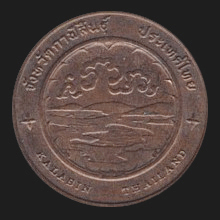|
Kalasin (กาฬสินธุ์)
Thai-Pali-Sanskrit. ‘Black water’ or ‘black river’. Name of a
province (map),
as well as its capital city, in Northeast Thailand, 519 kms
Northeast of
Bangkok.
The name comes from the fact that the area
around the town of Kalasin has many still and natural waters (sin),
such as marshes, swamps, ponds, creeks and brooks. The water in
these is very often dark or black (kala),
hence the name given to the city.
Although the
first town in the province was founded only in 1793, archeological
excavations have shown that people of the
Lawa
tribe have lived in the area since ancient times, probably already
since the 5th century AD. Besides this, also 120 million year-old
dinosaur fossils (fig.) have been excavated at Phu Kum Khao, in the
district of Sahatsakhan. At this dinosaur site, the largest of its
kind in Thailand, more than 700 fossilized bones were found and in
the nearby Phu Faek Forest Park, in the district of Huai Peung,
several large dinosaur footprints were discovered. In the beginning
of the twentieth century the town of Kalasin was made into a
province, but in 1932 this province was done away with and the area
was incorporated in the province of
Maha Sarakham, only to be re-established
again in 1947. Kalasin is a
mainly agricultural province covered by a
hilly landscape which allowed the creation of a large dam and water
reservoir for flood prevention and irrigation. The province
has at present fourteen
amphur and four
king amphur, 134
tambon and 1,509 villages, called
mu ban
in Thai. See also
Kalasin data file.
回






|

